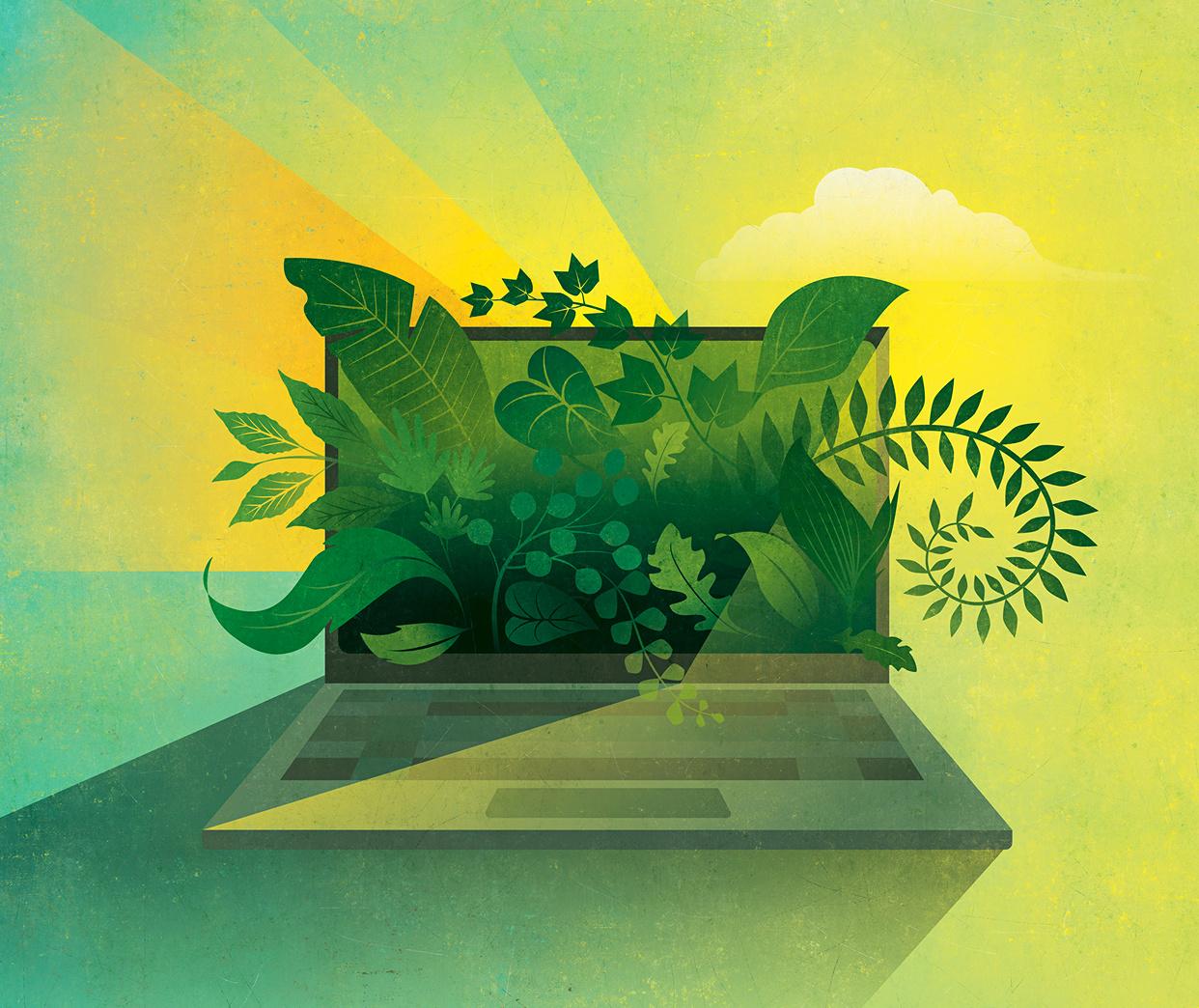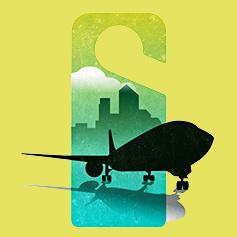
19 minute read
TRAVELING LIGHTER Dreaming
B E H ERE NOW
Af ter a lifetime of wanderlust, author Alexandra Fuller renounced flying in order to help save the planet—and herself.
Advertisement
IN 2015, MY BRITISH-BORN FATHER died of pneumonia
Iwhile he and my mother were on a rare holiday in Budapest, far from their farm in the Middle Zambezi Valley. I flew from Wyoming to be with him in a ramshackle, communist-era ICU room, where we sweltered in a heat wave. Three days before he died, Dad begged me to take him and my mother home to Zambia. I considered renting a van, driving him out of Hungary and across Europe to the Rock of Gibraltar; at least he’d die in sight of the continent on which he’d spent 50 years of his wild, wondrous life restlessly farming across southern Africa. But even if I didn’t kill him getting down the stairs—the elevators were broken—the city roads were clogged with an impenetrable murmur of Syrian, Afghan, and South
Sudanese refugees, human grief in motion. I remember thinking: The times we’ve been warned about are upon us. The rivers of displaced people arriving in Europe from war-ravaged, climate-destroyed parts of the world; lives wrecked, motherlands abandoned, families torn asunder. It felt wrong to insist on laying my dead to rest so far away when there was such unrest among the living right here. I’d been inching toward such an awakening for years: I could travel freely, and I did, but so many refugees are forced to roam due to ecological disasters caused by our rapidly changing environment. Climate change that is aggravated by the devastating harm of an airplane habit like mine. All my adult life I’ve traveled for work and love, which for me are mostly the same thing. From my mid-20s, I’d flown yearly, at least, between Zambia, where my parents had finally settled, and my home in Wyoming, coming and going as if I could afford the carbon, as if the planet could. And I’d flown for work, for magazine articles and book tours—to
Angola, Haiti, Mozambique, Namibia, Chile,
London, Paris, Rome, Mexico City, New York City, this city, that city. Just typing the names, I can feel the drug of it, adrenaline and awe, the rush of being in unfamiliar places, breath taken by the speed of it all. But the constant motion didn’t always feel right, and not just for environmental reasons. It shouldn’t be logistically possible to get from the Zambezi River to Wyoming, for example, in less than two days, because emotionally, it is impossible. The shock is too much, the contrast too raw. Still, I did it, the jetlag hangover, driven by the fear of what would happen if I stopped; fear of missing out, of work Tips for exploring the earth without exploiting it.
1PICK THE SCENIC ROUTE. “From anywhere in the United States, you can likely get to a foreign country, an ocean, or a mountain in a two-day-or-less drive,” says Karl Coplan, author of Live Sustainably Now. Up your road-trip game by renting a hybrid or elec tric car. The Nissan LEAF can go up to 226 miles on a single charge, enough to drive from Boston to Rhode Island’s beaches, Vermont ’s peaks, or the concrete canyons of New York City. Or hop on a twowheeler: USA Bike Tours of fers guided and self-guided trips in ever y state and Canada.
2FLY MINDFULLY. If you must be airborne, go nonstop. “It takes a lot of energy to get a 500,000-pound airliner up and back down,” says Annie Petsonk, international counsel for the Environmental Defense Fund. The lighter the plane, the less fuel required, so pack wisely, and try booking through the search engine Skyscanner, which uses a green leaf to denote lower-emission flights, chosen by a formula that considers fuel efficiency, trip distance, and seat capacity.
3TAKE THE ROAD LESS TRAVELED. “Ask, ‘Does this place need me?‘” says Bret Love, cofounder and editor in chief of the website Green Global Travel. “We have a huge problem with overtourism, crowds polluting the environment and consuming vast amounts of resources. Cities like Venice and Barcelona are basically at a point where tourists aren’t welcome. ” If you truly have to see Venice before you die, go, says
Love—but do so in the off-peak or shoulder season, when it will be less busy. Another way to avoid crowds? Don’t pick a spot just for the ’gram—chances are everyone’s seen that shot already. Think of the poor sunflowers of Bogle Seeds farm in Ontario, trampled by hordes of selfie seekers who arrived in roughly 7,000 cars one Saturday in 2018—leading the owners to close the fields to the public.
4GO LOCAL. According to the UN, as little as 5 percent of international travel spending in developing countries enriches the destination—the majority is gobbled up by hotel chains and other companies headquartered elsewhere. Wherever you’re headed, seek out small businesses. “You’ll put money back into the area and meet insiders who can tell you about off-the-beaten-path spots,” says Love. “A few years ago, I took a local-run tour of Scotland’s Isle of Skye, home of the Fairy Pools. Our guide told us about a couple that aren’t on any maps—we got to spend the day at a waterfall and didn’t see a soul.” When you’re abroad, stay long enough to get to know the wonders of each place, rather than checking off a list of in-and-out excursions, which bring little profit to communities but have a heavy impact on their infrastructure. Hallstatt, Austria, reportedly the inspiration for the village in Frozen, has capped the number of tour buses allowed in town per day and is entreating visitors to linger for more than two hours so they can explore—and spend a bit of money locally—rather than snapping a few shots and hightailing it out of there. As Love says, “‘Slow travel’ is better travel.” —Amy Maclin
Percentage increase in global carbon dioxide emissions from commercial aviation from 2013 to 2018, largely due to arise in the number of flights.
—International Council on Clean Transportation

DESTINATION ANYWHERE
While Covid-19 paused most jaunts, one type of tourism soared: virtual travel. And it shows no signs of stopping as people start circulating again. Whether you can’t hit the road for health or budget reasons, have put yourself on a flight diet for the good of the planet, or want to immerse yourself in a locale before a dream trip, you’ve got a growing number of options to see the world without leaving home.
READ ALL ABOUT IT. Emily Dickinson was right: “ There is no Frigate like a Book / To take us Lands away.” Type a destination into TripFic tion’s database, and it will recommend novels or nonfic tion set there. TAKE A GUIDED TOUR. Sure, you can wander streets and landmarks for free on Google Ear th’s Voyager. But for the inside stor y on a landmark or a cit y, travel with an exper t. Clio Muse Tours sells 23 vir tual excursions led by archaeologist s, historians, and guides in five countries for $4 to $19. There are five free previews on the site, too, so you can have a taste of a tour before commit ting.
TRY A BITE. A subscription from Snack Crate or Universal Yums delivers a box of packaged treats from a dif ferent countr y ever y month, along with some mind candy: a booklet of trivia and recipes about the place from Universal Yums, or a collec tion of fun fac ts and a playlist from SnackCrate. If you’re cut ting down on shipping emissions too, cook a meal instead—Spoon’s vir tual classes pair you with chefs around the world so you can whip up paratha with Shveta in India, or sopa de lima with Sofia in Mexico.
GO ADVENTURING. You can look for lions, leopards, rhinos, elephants, and buffalo on a WILDwatch LIVE game drive livestreamed by safari out fit ter &Beyond. For more heart-pounding excursions, pull on a virtual reality headset—they now cost as little as $200—and explore via virtual travel companies. GlobetrotterVR leads diving trips to shipwrecks and coral reefs, and Virtually Visiting guides snowmobiling or outings to view the northern lights in the Arctic Circle. REACH FOR THE S TAR S. Before you put away that VR headset, go to the YouTube channel of We the Curious, a British science museum, for an astrophysicist-led tour of six exoplanets—destinations you’re highly unlikely to reach by plane. —Eleni N. Gage

drying up, of becoming irrelevant, of not seeing places and people I love.
Returning home after my father’s memorial service in Zambia—attended mostly by people who’d never left the river’s banks, let alone the country—I decided to follow the advice of every guru ever and be the change. I assessed my carbon footprint to see where I could mend, amend. I had three kids and more pets. Plus, I used the web; studies show the data centers running internet activity produce roughly the same amount of carbon emissions as aviation, each search adding up. I drank tea from India, ate grapes from Chile; if shipping were a country, it would be the earth’s sixth-largest polluter. And on top of it all, the flying.
I couldn’t give up everything, but I knew I had to eliminate something. And because it was easier than undoing the miracle of my three children, relinquishing dogs or tea, or quitting Google, I vowed to give up flying. It was a vow I made a half dozen times in the three years following my father’s death. Every environmental disaster would inspire fresh resolve. The polar bears were starving on their melting islands of ice; Australia’s Great Barrier Reef was dying; California raged with wildfires. I’d ground myself for two months, six, even nine. Then an editor would call with a story in Ethiopia, South Africa, Madagascar. ONE LAST TIME, I’d vow. Just one more journey. I had excuses; traveling is how I make stories, stories are
Ohow I make a living. Also, I felt compelled to go, as if there were a wanderlust mechanism inside me, like a bird’s impulse to migrate. But it was arrogance and ignorance that really kept me airborne.
I was 46 when my father died. It was the sadness of a whole lifetime ripening; I thought I’d never know sorrow like it. Then this happened. In early July 2018, my son, Fi—the middle of my three children, the steady one I worried about the least—died, too, taken by an inexplicable seizure in his sleep in the western Wyoming valley where he’d been born 22 years earlier. You can’t know much in the first searing weeks and months of that kind of grief, just the sparkling white horror. But I knew right away that Fi’s death removed illusions for me; everything wouldn’t miraculously work out in the end. I was wide awake, and I could no longer lie or deny or equivocate. The comforting excuses we have for our behaviors, those casual hypocrisies, stopped working for me.
Mars burned red in the sky the awful, long summer that Fi died, and in September, wildfires tore through the Wind River Mountains. Grief is an inferno; it blazed into fall and beyond the first snowstorms in October. I spent Thanksgiving with a friend who had suffered her own recent loss, our eyes turned upward, watching the moon rise, full and creamy in a desert indigo sky. When an airplane flew past it, creating an illuminated zero, as if to say, no more—a celestial stop sign—I knew my game was up. In mourning, I’d become accustomed to God speaking to me in obvious symbols like this.
“That’s it,” I said. “I’m done with planes. I need to stay home and plant trees.” I was determined to stop flying, to stay put where my son is buried, and to reconcile my body and my inconsolable shadow. I couldn’t ignore the toll anymore, the images of mothers holding dead children after floods, hurricanes, tornadoes, disasters caused by a destabilized climate that my own trips
WALKING THE WALK
Greenwashing is “ when companies address sustainability through PR instead of meaning ful action,” says John Hocevar, oceans campaign director for Greenpeace USA. Here’s how to find an“eco -resort” that lives up to its name.
LOOK AT THE LABELS. Those eco-seals on a hotel’s website mean something—usually. While some sustainable endorsements are pay-to-play designations that companies “earn” simply by forking over a membership fee, others, such as Green Key Global or Green Seal, have a stringent certification process. How can you tell the difference? The Global Sustainable Tourism Council lists 23 organizations that meet its standards in the “For Travelers” section of its site, gstc.org. If a label’s not there, visit the website of the certifying body itself to learn its requirements. They should be looking at the property’s environmental practices, clean energy usage, and impact on the community. DO A TARGETED SEARCH. Websites like Bookdif ferent and ResponsibleVacation of fer more than a million real-deal vet ted spot s to rest your eco-conscious head, searchable by location, price, and ac tivities. If booking a more sustainable flight is a priority, visit atmosfair.de to check out the Airline Index compiled by Atmosfair, a nonprofit focusing on making travel more climate-friendly. GO STRAIGHT TO THE SOURCE. A business that doesn’t have an of ficial s tamp of approval might s till be sus tainable. If you like a hotel or tour company but can’t find enough info on it s website, simply call and ask to chat with management. At responsibletravel.org, the Center for Responsible Travel recommends asking ques tions such as “ What are your environmental prac tices? ” and “Do you suppor t any local conser vation or communit y development programs? ” —Katherine Pittman
Percentage of global greenhouse gas emissions that can be traced direc tly to tourism.
—2018 study published in Nature Climate Change that monitored 160 countries between 2009 and 2013
E X T R A C R E D I T
Carbon offsets may take some of the guilt out of your trip.
WANT TO OFFLOAD some flygskam (that’s Swedish for “flight shame”)? Consider buying carbon offsets, which fund projects that put carbon dioxide back into forests, soil, and wetlands or reduce emissions from landfills, farms, and other sources. At sites like Cool Effect and Carbon Footprint, you can enter your flight details, learn your share of the emissions, and buy a corresponding number of credits. Say you’re planning to fly round-trip from NYC to London: The calculator at Carbon Footprint estimates your portion at 1.66 metric tons. Click “Offset Now” and you get a range of projects to pick from—say, reforestation in Kenya ($24.59 for two metric tons) or clean water initiatives in developing countries ($17.19 for 1.66 metric tons).
Not all offsets are equal, warns Peter Miller, director of the western region of the Climate and Clean Energy Program at the Natural Resources Defense Council: “Projects need to operate under clearly defined requirements that are verified by a third party, and must be ‘additional’—meaning they wouldn’t exist without this funding. ” Look for one that relies on protocols from a top registry like Verra or Climate Action Reserve.
Still, an offset isn’t a license to jet-set. “A round trip to Costa Rica has about the same footprint as 80 pounds of meat, ” says Live Sustainably Now author Karl Coplan. “I like the analogy of the Mediterranean diet, where meat is only occasional. Think of flying as a special treat.” —A.M.

MORE LIKE THIS, PLEASE!
We alone can’t protect the environment; industries have to pitch in as well. Transportation’s major players are betting these upgrades will help you make a cleaner getaway.

1FAT FUEL JetBlue— ”probably the most proac tive of the airlines,” according to Gregor y Miller, executive direc tor of the Center for Responsible Travel—aims to become carbonneutral on domestic flights this year, in par t by using more sustainable fuels. Already, some JetBlue flights out of San Francisco run par tly on Neste biofuel, which is made from animal and cooking fats; since it ’s created using waste materials, it has an 80 percent smaller carbon footprint over its lifecycle than conventional fuel. Currently, it ’s still being mixed with old-school fossil jet fuel, as planes cannot yet run solely on biofuels. “The technology isn’t there yet,” Miller says, “ but it ’s a good direc tion to go in.”
2OLD PLANES, NEW TRICKS Eighty-five to 90 percent of plane skeletons are reused or recycled, according to the Aircraft Fleet Recycling Association. Many parts are rehabbed into new planes, but the Belgian company Aerocircular has converted one section of fuselage into a training facility for police dogs and chopped another aircraft into pieces for use on a film set.
3WINDS OF CHANGE Coal-burning locomotives have gone the way of the Wild West, and today most trains—including subways—are elec tric. But there’s an even greener option. India, Australia, and England run wind- or solarpowered models on some shor ter routes, and Dutch trains have been wind-powered since 2017; according to the Dutch national railway, a windmill running for just one hour can power a train for 120 miles. —K.P.

Percentage of 2019’s global GDP accounted for by tourism—that ’s 1 in 10 jobs worldwide.
–World Travel & Tourism Council
upended even further. I knew what it felt like to scream the wrongness of what is into the ears of a deaf universe. I couldn’t ignore my contributions to an increasingly uninhabitable planet, already hotter than scientists had predicted five years earlier. I couldn’t be a part of what would make the world uninhabitable to my surviving children—all surviving children.
EVEN AFTER THAT, I didn’t stop flying right away. I took a few last trips, love-miles I deemed worth it—final
Efarewells, a momentous bunch of carefully considered lasts. I went home to Zimbabwe and Zambia to say goodbye to the lands that raised me, to my mother and sister, to the Zambezi River and the miraculous insistence of life along its banks.
When I started to turn down work and invitations, refusing to fly, people reacted much as they had years earlier when I’d stopped drinking. One applauded my morality, a few defensively assumed my decision was an indictment of their flying, more insisted I’d fly again, and many said things like “We all do what we can.” But that isn’t true. Most of us do what we can get away with—I know I did.
Then the world quarantined to a halt, and the thing that stopped everyone traveling stopped me. On my third week of self-isolation during the Pandemic of 2020, as the Antarctic experienced an unprecedented heat wave, I asked myself, again, What will it take for me to take root, if not this? I vowed again, for the last time, no more planes for me. Here was the universal parallel between the vow I kept making and the question we all found ourselves asking: Is this trip worth endangering the people I’m going to see, the community I live in, the world at large?
Sitting with my dying father, the flow of refugees in the streets, the Danube boiling, I thought, Surely, we all need to rest in place. Take a breath. Ask ourselves, What’s essential? What isn’t? Now I know my answer: I can drive less, use the internet less, write deeper, garden better, read and reread my library. I can plant more trees, compost, reduce, rest. I can be more grounded, less addicted, because I am, literally, grounded; it’s my response to this halted world.
So, here I stay in the northern Rockies. Unless by sailboat, then by road or rail, I won’t see Mum again, her joyous, ever-replenishing pack of dogs, the farm, the
Zambezi. Or my sister, in her thatched house near the
Kafue River. We’re not au fait with the quarantine-era technology of video chats. We can send letters, though; it’ll be like boarding school, but forever.
As I write this on a sunny day in the Rockies, there are chickadees animating the aspens like tiny ascetic monks. We’ve commented on it, my dairyfarmer neighbor and I, the beautiful drama of stillness, about which he knows everything; he has left his farm for only one night in the past 50 years. In our flyover state, there’s flying pollution. Now, with air travel down 95 percent, the skies above us are not besmirched with vapor trails; days are clear much like they were in his childhood. It’s such an abundance, right here, right now. And it’s already taken too much for me to see that the more still I become, the more the whole world is mine, all the time, infinitely.
ALEXANDRA FULLER is a memoirist whose latest book, Travel Light, Move Fast, is out in paperback in August.

WHILE COVID-19 wreaked havoc on the human population, the rest of the planet seemed to get a much-needed respite. Lions lolled on the roads of a national park in South Africa. The skies over some of urban China, usually blanketed in an acrid haze, had days of cr ystal clarity. After ten years of ignoring their Hong Kong zookeepers’ gentle encouragement, giant pandas Ying Ying and Le Le finally got in the mood to mate. Are pandemic travel patterns giving nature a chance to reset?
The consensus: It ’s complicated. The rise of remote working may have a lasting impac t on our skies, according to Lauri Mylly vir ta, lead analyst at the Centre for Research on Energy and Clean Air in Helsinki. He reports that in the weeks just after Covid-19 was declared a pandemic by the World Health Organization, carbon dioxide from passenger aviation dipped by more than 50 percent worldwide. “Af ter this experiment in telecommuting, it ’s very hard to see people going back to the same amount of business travel that we had before.” However, he adds, city dwellers who are skittish about public transportation might opt for air-befouling cars.
Although some species may flourish in the absence of humans— sea tur tles can nest more freely on beaches, and af ter decades of over fishing, our finned friends may enjoy an oppor tunit y to recover— the travel ban isn’t good news for all creatures. “In many areas, funding for conser vation depends on tourism,” says Joe Walston, executive vice president of the Wildlife Conser vation Societ y. “If that revenue dries up, budgets for protec ted areas are slashed and communit y income disappears, paving the way for poachers.”
One thing is for cer tain: There’s nothing like a pandemic to remind us that ever y ac tion inspires a reac tion, and ever y trip requires a cost-benefit analysis. Says Live Sustainably Now author Karl Coplan, “Hopefully, this will be an oppor tunit y for ever yone to look at their own contribution to what ’s happening in the world.” —A .M.
A BREATH OF FRESH AIR
Has the lockdown set nature free?










